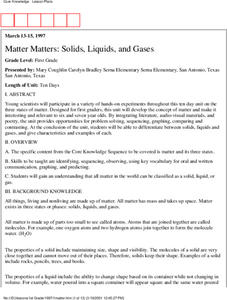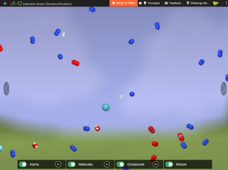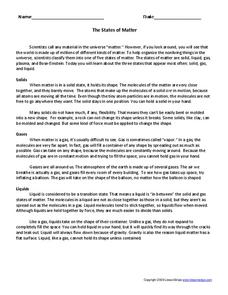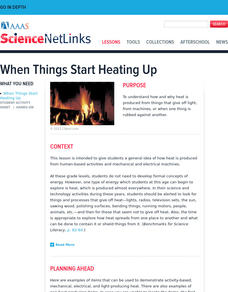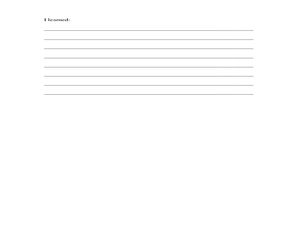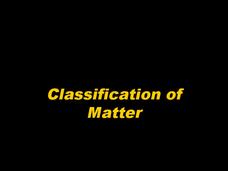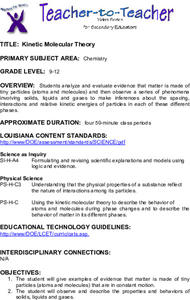Curated OER
What's Matter?
Students explore many of the basic properties of matter including atoms, ions, elements, molecules, and density. The class explores an interactive flash-animated Web site to answer questions and clarify misconceptions they might have had...
Curated OER
Matter Matters: Solids, Liquids and Gases
Scientists participate in a variety of hands-on experiments in this ten-day unit on the three states of matter. Lessons incorporate literature, a-v materials, and poetry to help learners differentiate between solids, liquids and gases.
Curated OER
Mixtures of Matter
Young scholars experiment with solids and liquids. In this mixtures of matter instructional activity, students combine matter to form solutions. Young scholars hypothesize, test, and analyze the data to draw conclusions. The...
Curated OER
Mixtures of Matter
Students experiment with mixtures of matter. In this matter lesson plan, students investigate which liquids form a solution when mixed together and which do not. Students also identify which solids can be separated from matter.
CK-12 Foundation
Air Matters
What makes up the air we breathe? Young scientists explore the atoms and molecules in the air. An interactive lesson allows individuals to watch the movement of the particles in the air and change the makeup from a mixture to a...
Curated OER
The Atom
In this atom worksheet, students read about the parts of the atom and how atoms combine into molecules and compounds. Students learn how to read a periodic table. This worksheet has 20 fill in the blank and 10 matching questions.
Curated OER
Atoms or Molecules?
In this scientific investigation worksheet, learners follow the provided procedures to examine the chemical reactions of hydrogen and oxygen atoms and then respond to 1 short answer question.
Curated OER
The States of Matter
In this states of matter worksheet, students learn about the 3 different states of matter and how matter shifts states. They then answer the 20 questions in the packet. The answers are on the last page.
Curated OER
Chemical Changes in Matter
In this matter and chemical changes activity, students write symbols and formulas for 2 chemical reactions. They write words for 1 chemical reaction given in symbols and formulas. They draw a diagram representing a chemical reaction and...
Curated OER
States of Matter
In this states of matter worksheet, students are given 15 statements and they fill in the blank with terms related to solids, liquids and gases and the transition from one state to another. Students use the clues to complete a crossword...
Curated OER
Three States of Matter
Third graders investigate the three states of matter and the properties of materials as they undergo physical changes. They identify examples of each type of matter, role-play atoms in solids, liquids, and gases, and conduct an...
Curated OER
Static Electricity 1: Introducing Atoms
Students explore webpages to research the nature of atoms, including electrons, protons, and neutrons. This lesson plan is the first of a four-part series on static electricity. They see that static electricity involves + and - charges.
Curated OER
Physical and Chemical Properties of Matter
Learners identify the physical and chemical properties of matter. They review the types of matter. Students list the four states of matter (Solid, Liquid, Gas and Plasma). They recognize and describe the different types of matter.
Curated OER
The Physical Behavior of Matter
Learners distinguish between three phases of matter: solid, liquid and gas, on the molecular level. They compare and predict the relative compressibility of the three phases of matter through journal writings and drawings.
Pearson
The Chemical Context of Life
An educational presentation includes atoms, molecules, the four major elements, as well as neutrons and protons. Additionally, slides focus on atomic number, mass number, atomic weight, polar and nonpolar covalent bonding, ionic...
Columbus City Schools
To Measure its Mass or Volume?
Atoms, elements, and molecules, oh my! Teaching the fundamentals of chemistry to curious sixth graders has never been easier to accomplish. Here is a resource that pulls together everything needed to get them off to a good start,...
Curated OER
Atomic Theory
An extremely thorough presentation walks new chemists through the basics of matter. There really isn't a unifying theme, however So many topics are covered: forces, elements, atomic structure, chemical properties, compounds, quarks,...
Curated OER
Water 1: Water and Ice
Students experiment with states of matter with water and ice. In this states of matter lesson plan, students experiment to discover what happens to water as it freezes to become a solid, ice. They observe what happens when ice melts back...
Curated OER
Heat and Matter
Students explore liquids and solids by conducting in class experiments. In this matter lesson, students define the properties of matter and how heat can change those properties. Students experiment with heating objects such as butter and...
Urbana School District
Fluids
In 1879, Sir William Crookes discovered the fourth state of matter, plasma. The presentation covers states of matter, phase changes, density, pressure Pascal's Principle, buoyant force, Archimedes' Principle, Bernoulli's Principle,...
Curated OER
Classification of Matter
Thirty-seven slides thoroughly shed light upon the four classes of matter: elements, compounds, mixtures, and solutions. Also covered are chemical symbols, molecules, and chemical equations. The colors and fonts chosen for the...
Curated OER
Building Blocks of Matter
Middle schoolers view videos and worksheets and construct a model of a water molecule. In this atomic structure lesson, students view video clips and handouts about matter and nanoscience. They construct a model of a water molecule with...
Curated OER
Changing and Atom
In this atom worksheet, students are given a diagram of the changes that occur in atoms. Students complete the diagram given a list of 4 terms that indicate the resulting product.
Curated OER
Kinetic Molecular Theory
High schoolers analyze and evaluate evidence that matter is made of tiny particles. They observe a series of phenomena involving solids, liquids, and gases to make inferences about the spacing, interactions and relative kinetic energies...



